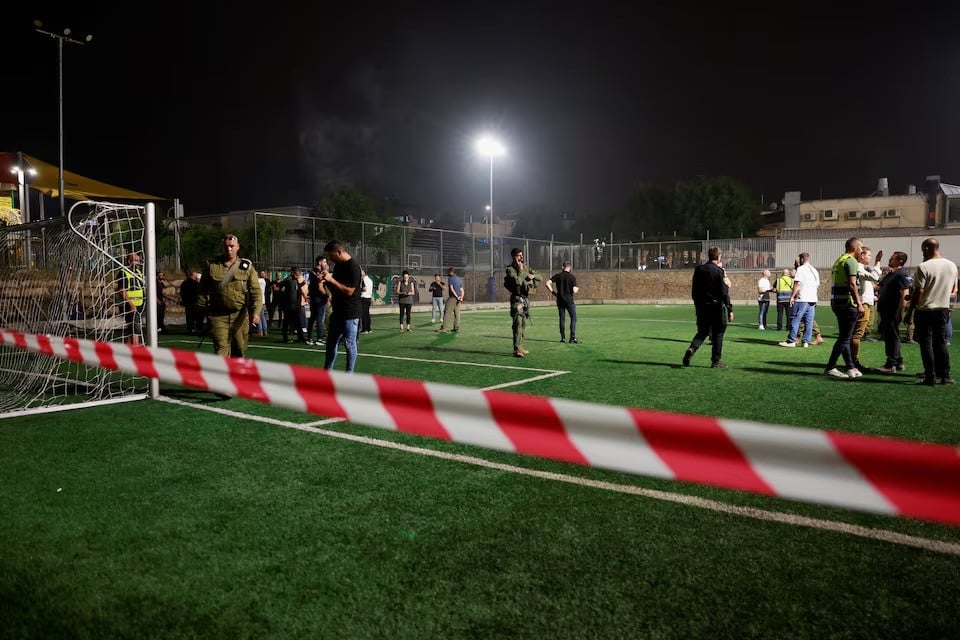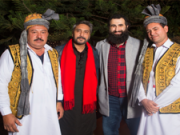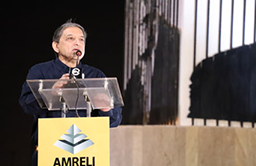Jerusalem/Beirut:
Twelve people, including children, were killed by a rocket attack on a football field in the Israeli-occupied Golan Heights on Saturday, according to Israeli authorities. They blamed Hezbollah and threatened to exact a hefty price on the Lebanese organization, which is supported by Iran.

The worst strike to have occurred in Israel or Israeli-annexed territory since the beginning of the Gaza conflict was denied by Hezbollah.
Fears of a full-scale battle between the heavily armed enemies have increased since the incident, which drastically escalated hostilities in the combat fought alongside the Gaza war.
The rocket hit a football field in the Druze village of Majdal Shams in the Israeli-occupied Golan Heights, which Israel annexed in a move that was not recognized by most nations after capturing the area from Syria in the 1967 Middle East conflict.
According to a statement from his office, Prime Minister Benjamin Netanyahu told the head of the Druze community in Israel over the phone that “Hezbollah will pay a heavy price, the kind it has thus far not paid.”
“The Islamic Resistance has absolutely nothing to do with the incident, and categorically denies all false allegations in this regard,” Hezbollah stated in a written statement.
Hezbollah had previously declared that it will launch multiple rocket strikes at Israeli military installations.
The rocket that struck the soccer pitch, which at the time was crowded with kids and teenagers, injured 13 other persons, according to the Israeli ambulance service.
“They were playing soccer when they heard sirens and fled for cover; it might have taken them fifteen seconds to get there. However, the missile struck the area between the ground and the shelter, making it impossible for them to approach it, according to witness Mourhaf Abu Saleh.
Social media footage captured the instant the rocket struck. There’s the sound of an air raid alarm, a loud explosion, and billowing smoke images. Because the structure and arrangement of the roads matched the satellite photos of the region, Reuters was able to independently confirm the location.
First responders found a scene ravaged, according to Magen David Adom ambulance service medic Idan Avshalom. “There were casualties on the grass and the scene was gruesome,” he stated.
Netanyahu declared he would move his trip forward and call a meeting of his security cabinet when he returned to Israel late on Saturday, ahead of schedule from the United States.
Leading diplomatic efforts to defuse tensions along the Israeli-Lebanese border, the US denounced the attack as horrifying and reaffirmed its “iron-clad and unwavering” support for Israel’s security against all terrorist organizations backed by Iran, including Lebanese Hezbollah.
The White House National Security Council spokesperson stated in a statement that the US “will continue to support efforts to end these terrible attacks along the Blue Line, which must be a top priority.” The boundary separating Israel and Lebanon is known as the “Blue Line.”
Iranian-made missile
According to the Israeli military, the rocket fire was conducted from a location north of the southern Lebanon settlement of Chebaa.
Israeli military spokesman Rear Admiral Daniel Hagari told reporters at Majdal Shams that forensics revealed the rocket was an Iranian-made Falaq-1.
Hezbollah had earlier declared that it had fired a Falaq-1 missile on Saturday, claiming to have hit an Israeli military facility.
Hagari also stated in a public address that Home Front Command instructions had not changed as of yet, indicating that the army did not anticipate an impending escalation throughout Israel.
Finance Minister Bezalel Smotrich, an ally of Netanyahu’s far-right coalition, demanded harsh reprisals, naming Sayyed Hassan Nasrallah as the head of Hezbollah among others.
It is Nasrallah’s head that should pay for the deaths of children. “Lebanon as a whole ought to pay,” Smotrich wrote on X.
Tens of thousands of people have been forced to flee their homes in Israel and Lebanon due to the fighting. Approximately 350 Hezbollah members and over 100 civilians, including journalists, children, and medical professionals, have been murdered in Israeli strikes in Lebanon.
Following Saturday’s incident, the Israeli military announced that at least 17 troops and 23 civilians had died as a result of Hezbollah attacks since October.
The UNIFIL peacekeeping force, which is stationed in southern Lebanon, has been in communication with Israeli and Lebanese authorities “to understand the details of the Majdal Shams incident and to maintain calm,” according to Andrea Tenenti, a spokesperson for the force, who spoke to Reuters.
According to a top diplomat specializing in Lebanon, every effort must now be made to prevent a full-scale conflict.
Attacks coming from Lebanon
Since October, a network of Iranian-backed organizations has emerged throughout the Middle East to help Hamas, the Palestinian ally, with Hezbollah being the most potent of them.
Israel has been fired upon by both Yemeni Houthis and Iraqi factions. Both Hamas and the Sunni organization Jama’a Islamiya in Lebanon have launched rocket strikes against Israel.
Over 40,000 individuals, predominantly Druze, call the Israeli-occupied Golan home. An Arab minority who follow a branch of Islam are known as the Druze.
The soccer field attack came after an Israeli strike in Lebanon on Saturday that claimed the lives of four militants. The four fighters killed in the Israeli strike on Kfarkila in southern Lebanon, according to two security sources in Lebanon, belonged to several armed factions, at least one of which was Hezbollah.
The Israeli military said that after spotting a militant cell entering the premises, its planes had hit a Hezbollah military facility.
The military said that at least thirty rockets were fired across the border from Lebanon at that point.
In response to the Kfarkila strikes, Hezbollah claimed at least four attacks, including the use of Katyusha rockets.










































